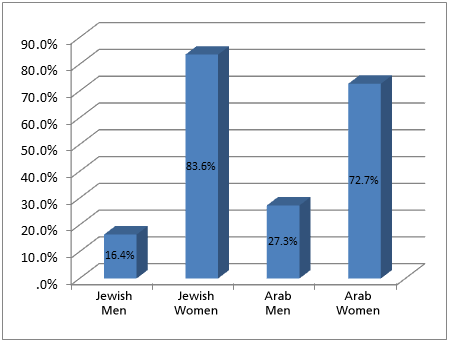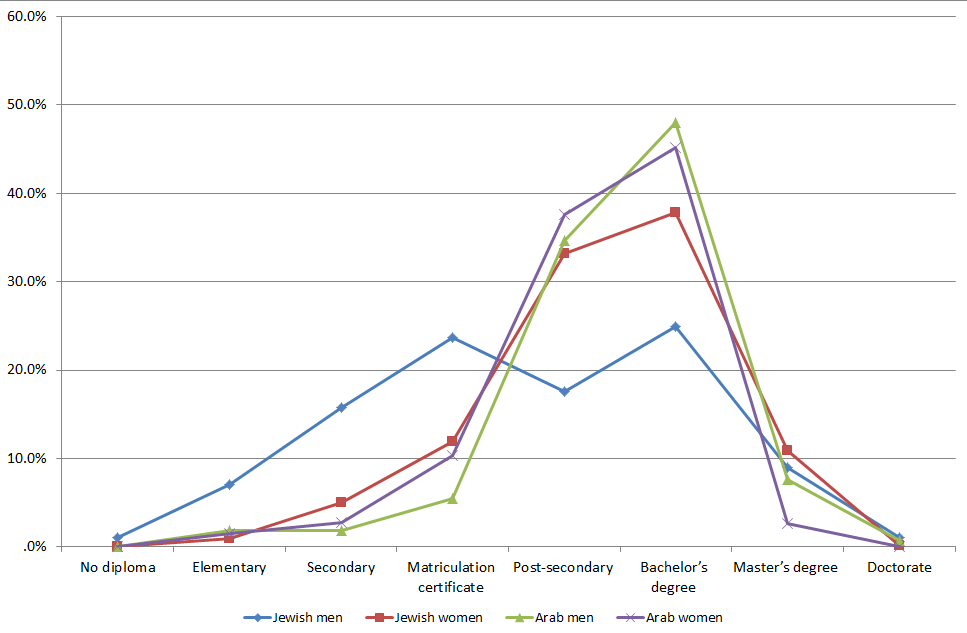Do Educational Gaps between Elementary School Teachers Have an Impact on Achievement Gaps between Jewish and Arab Schools?
Dr. Nabil Khattab, head of IDI’s Arab-Jewish Relations project, explores whether there are gaps in the level of formal education required of elementary school teachers in the Arab and Jewish sectors in Israel and the level of education that they actually attain, and possible connections with the gaps in achievement between Jewish and Arab schools.
Introduction
In this short article, I examine the degree of correspondenceMethodological note: There is more than one way to calculate the degree to which a person’s education matches the education required by his/her profession. The method I chose is based on calculating the distances (i.e., the gaps) between the most advanced degree received by an individual and the most common degree held by members of that profession. Since I employed an 8-point scale (0–7), the difference scale could, in theory, have the range of minus 7 to plus 7. In addition, because there were comparatively very few cases at the extremes of the scale, as had been expected, on each side I combined the four extreme values into a single category. between the level of formal education required of elementary school teachers in Arab and Jewish schools in Israel and the level of education they actually attain. I present the formal educational profile of the teachers and investigate the gaps between the men and women in situations of mismatch, while emphasizing the similarities and differences between the Arab and Jewish educators. I argue that although certain differences exist between the educational profiles of the teachers in the two sectors, these differences do not necessarily help us understand the gaps in educational achievement between Arab and Jewish students.
The Gender Composition of Elementary School Teachers
Most of the teachers in Jewish and Arab elementary schools in Israel are women (see Figure 1). The percentage of male teachers in Arab elementary schools is slightly higher than that in Jewish schools. This difference is related to, among other things, a different opportunity structure and other internal factors. The gender distribution in both sectors, however, is clear and consistent.
Figure 1: Gender of Elementary School Teachers, Age 21–59, by Ethnicity

Source: Computed from data of the Labor Force Surveys of the
Central Bureau of Statistics, 2000–2010
The Profile of Formal Education of Elementary School Teachers
The educational profiles of male Arab teachers, female Arab teachers, and female Jewish teachers are similar (see Figure 2), and somewhat different than that the educational profile of the male Jewish teachers. Whereas most of the Arab men, Arab women, and Jewish women studied have some post-secondary education and hold a bachelor’s degrees, almost half of the male Jewish teachers have only a matriculation certificate and some don’t even have that.
Figure 2: Formal Education of Elementary School Teachers, Age 21–59, by Ethnicity and Gender

Source: Computed from data of the Labor Force Surveys of the Central Bureau of Statistics, 2000–2010
Despite the overall similarity in the educational profiles of the female Jewish teachers and the Arab teachers of both genders, some differences are apparent, especially at the ends of the scale. There is a slightly higher proportion of Jewish women who have less than a matriculation certificate or, alternatively, more than a bachelor’s degree. However, these differences do not affect the overall trend, which is that the profile of the male Jewish teachers differs from that of the other three groups.
Mismatch between the Requirements of the Profession and the Actual Education of Elementary School Teachers
A discernible difference exists between the demands of the profession and the formal education of elementary school teachers (see Figure 3). As expected, the figure shows that Jewish men are the group with the lowest level of formal education as compared to the demands of the profession (under-education). Only about 25% of them are in the “full match” category (level 0 on the scale), with about 60% of them on the negative part of the scale, which represents under-education. It is likely that beyond their formal education, these men received additional training in the Israeli army, which would compensate for their lack of a diploma. However, this explanation is merely a hypothesis; further research is needed to explore this in depth.
The distribution of the mismatch among Arab men and among women from both sectors is nearly identical. However, the female Jewish teachers have a relative advantage over the female Arab teachers, expressed in a larger percentage of over-educated Jewish women, especially in levels 1 and 2. Whereas about 25% of the female Jewish teachers are on the positive side of the mismatch scale (over-education), only about 10% of the Arab women are on this side of the scale, even though the teaching faculties of comparable schools in the Arab sector display adequate quality. The figure also shows that the lowest percentage of under-education is found among male Arab teachers, and that male Arab teachers are no less represented in the ranks of the over-educated than are Jewish women. However, their influence is limited and is less than that of the Jewish women, because of their small numbers in this profession.
Figure 3: Mismatch in Required Education and Actual Education of Elementary School Teachers, Age 21–59, by Ethnicity and Gender

Source: Computed from data of the Labor Force Surveys of the
Central Bureau of Statistics, 2000–2010
The existence of under-education, a situation in which teachers are less educated than is common or appropriate for the profession, is evidence of the limitation or reduction of human capital, an important component in determining the quality and productivity of the labor force in a given sector. The fact that Arab women are not over-represented in the ranks of the under-educated (ranks –1 to –3), as compared to Jewish women, suggests that their human capital is not reduced compared to their Jewish counterparts or that there is no significant gap between the two sectors. The relatively high rate of over-education among Jewish women may, in fact, suggest a problem rather than a desirable condition, since over-education is generally accompanied by mismatch unemployment, which is a structural and economic problem that has negative consequences for workers and the economy alike.
Conclusion
There is no significant difference between the quality of Arab teachers and that of their Jewish counterparts in Israeli elementary schools in terms of their formal credentialsThis article focused only on the formal training of the teachers and did not examine their performance or the quality of their work. There is a difference between the quality of the workforce in formal terms and the quality of its teaching, which is influenced by additional factors.. The over-representation of Jewish men in the categories related to under-education does not carry decisive weight because of the small number of Jewish men in the educational workforce in elementary schools and because the under-education of the Jewish men is offset by the over-education found among the Jewish women working in education.
Because the small differences found in this study cannot account for the achievement gaps between Jewish and Arab elementary school students, as demonstrated by the results of the Meitzav tests, the spotlight should be directed elsewhere. The differences, for example, may be attributed to differences in teacher dedication and performance, the infrastructure and resources available to Arab schools versus Jewish schools, the role of the family and home, internal factors like motivation and goals, and, of course, the student’s place of residence and the nature of his or her immediate surroundings.
Dr. Nabil Khattab is head of IDI's Arab-Jewish Relations project and a Senior Lecturer in the Department of Sociology of the Hebrew University of Jerusalem.
